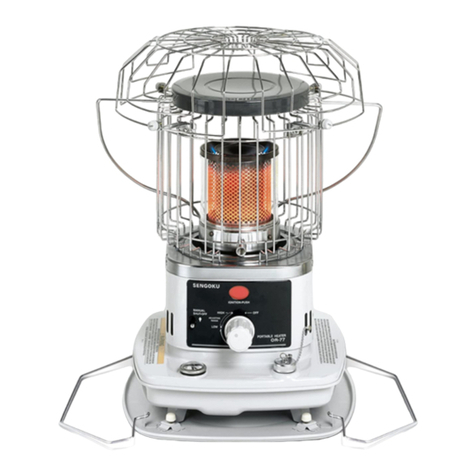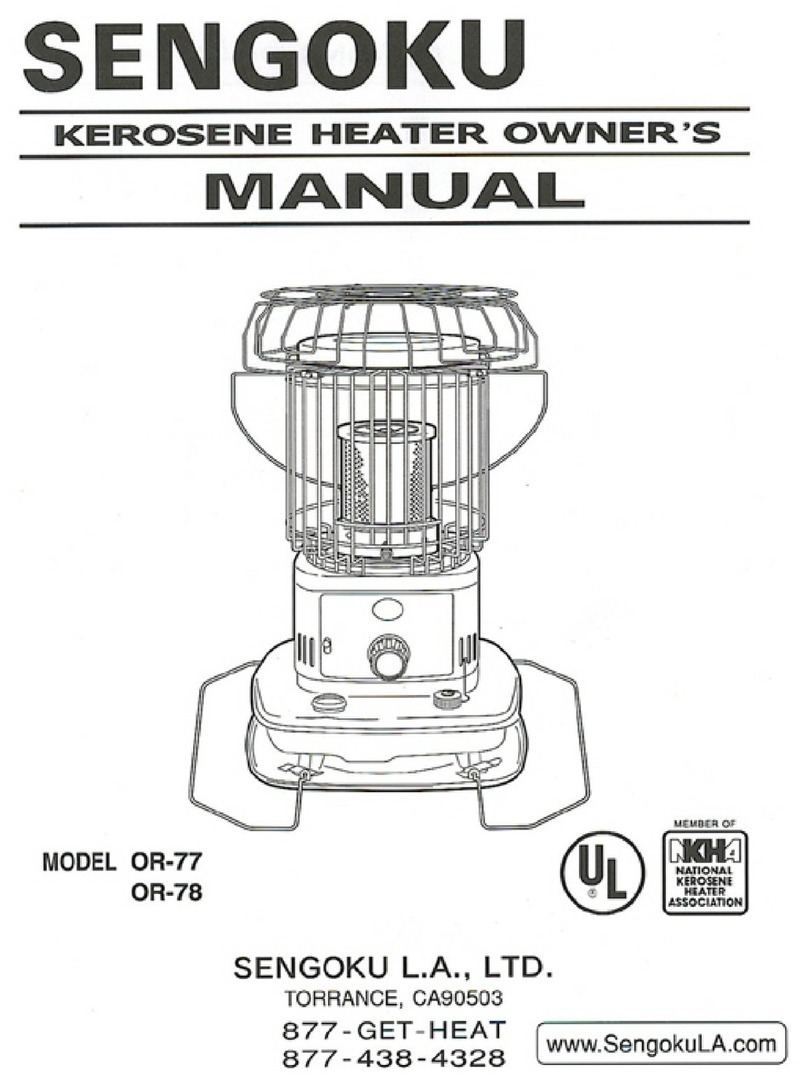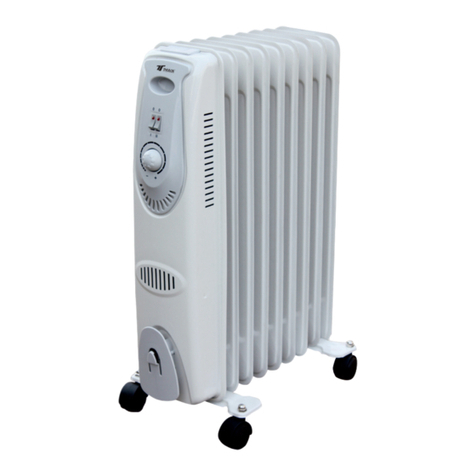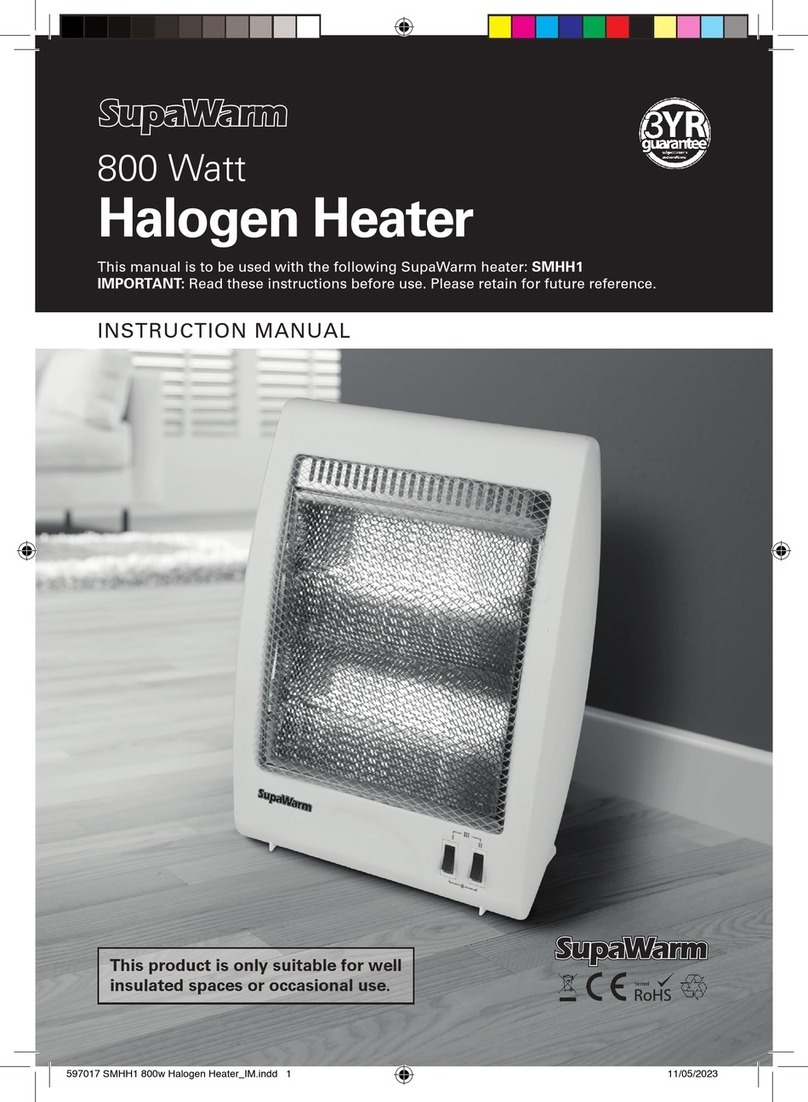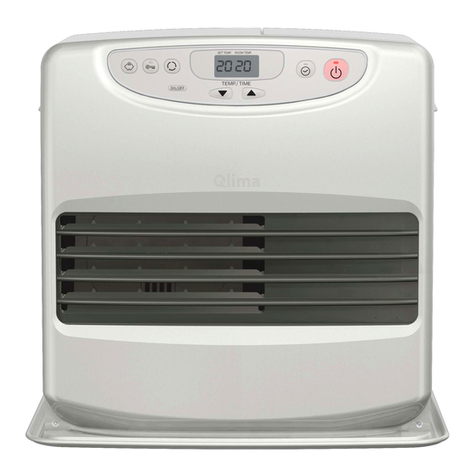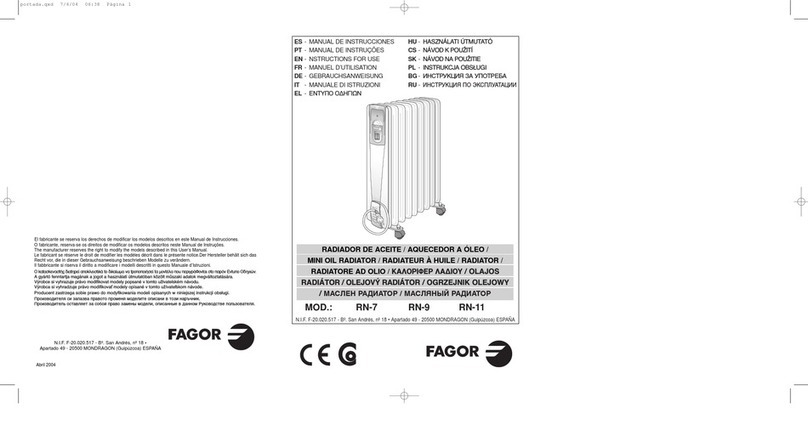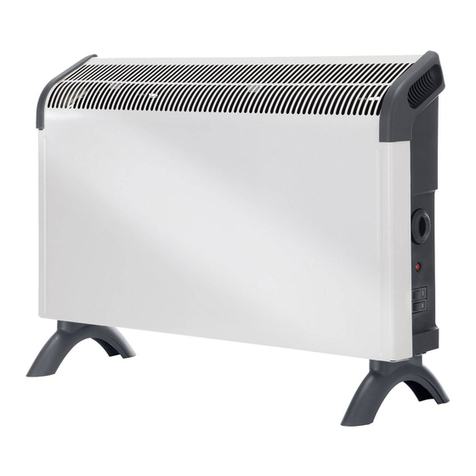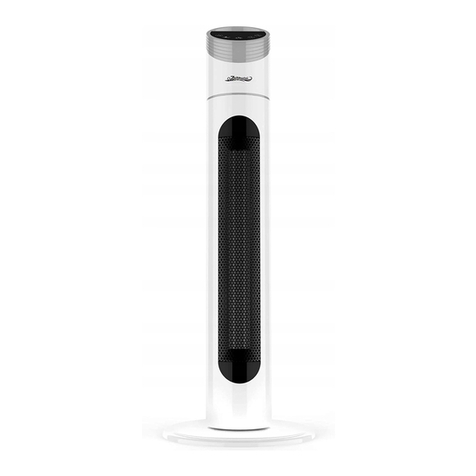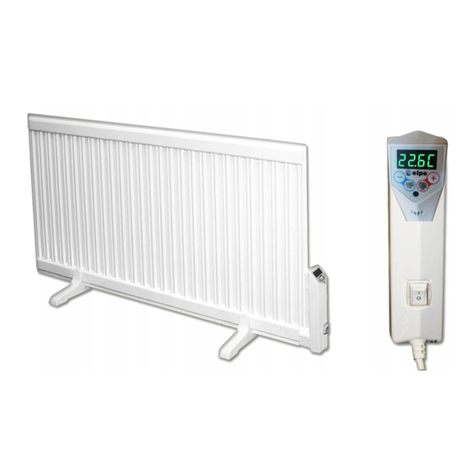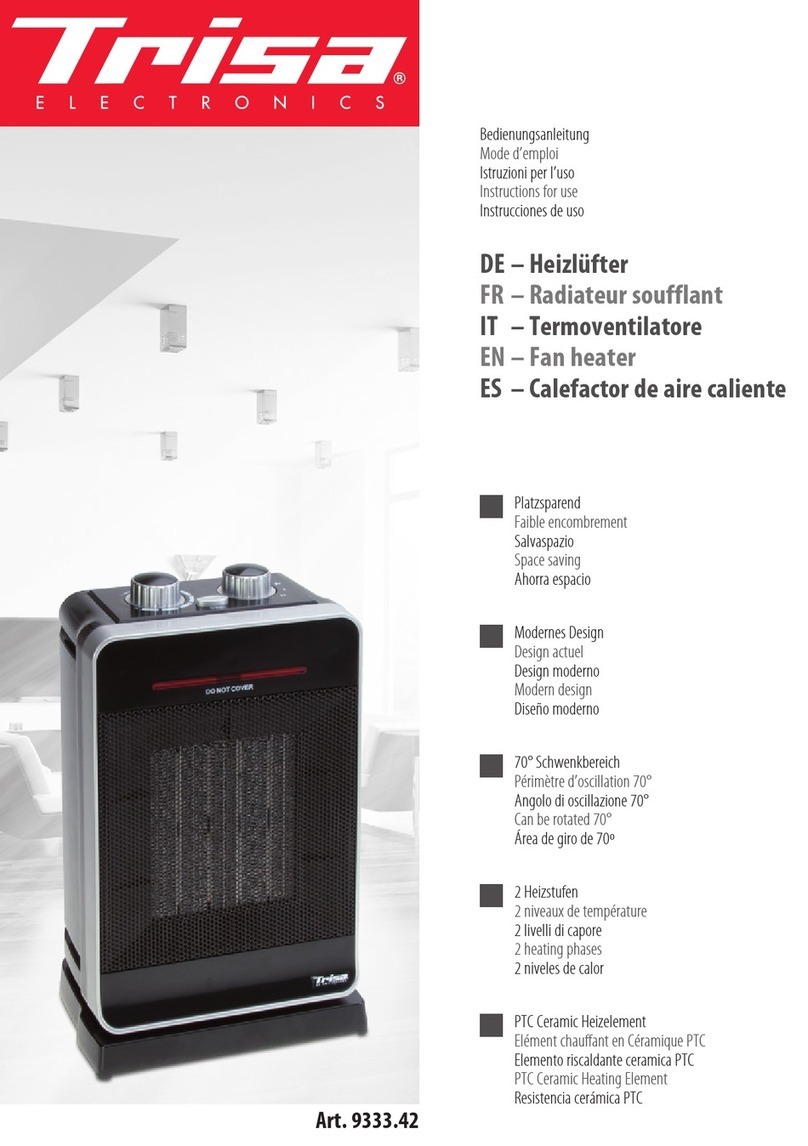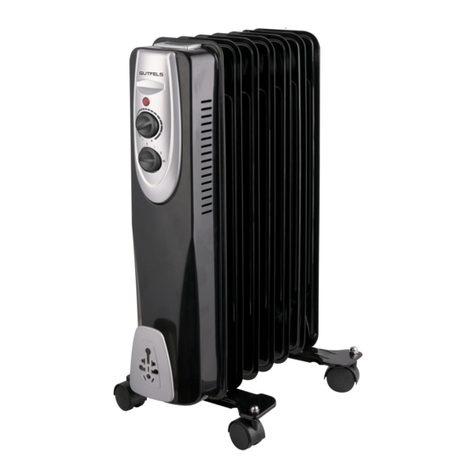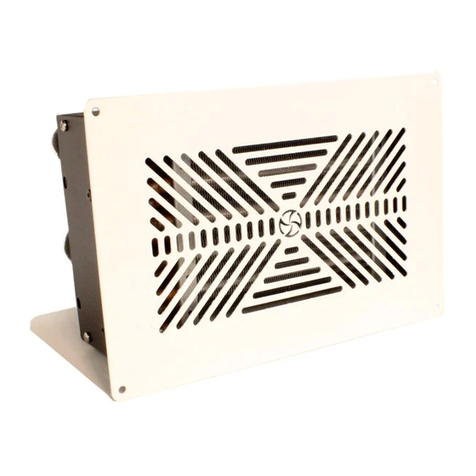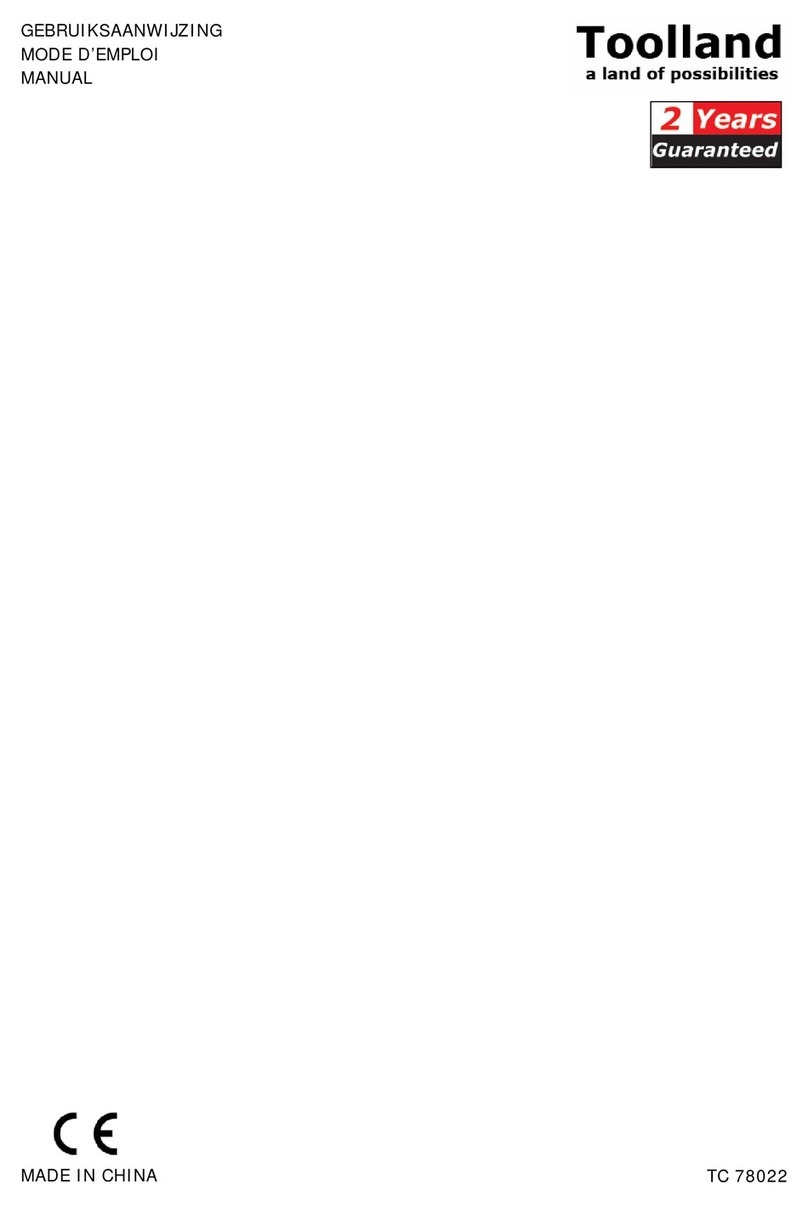Sengoku MGN -110 User manual

SENGOKU L.A., LTD.
TORRANCE, CA
90503
877-
GET
-
HEAT
877-438-4328
MANUAL
www.SengokuLA.com
MODEL
MGN
-110,
CTN
-110,
HMN
-110
SPANISH MANUAL INSIDE

1.WARNING:
FAILURE TO INSTALL, MAINTAIN, AND/OR
OPERATE THIS KEROSENE HEATER ACCORD-
ING TO MANUFACTURER'S INSTRUCTIONS MAY
RESULT IN CONDITIONS WHICH CAN PRODUCE
BODILY INJURY AND/OR PROPERTY DAMAGE.
NOTE: The WARNING and IMPORTANT Instructions
appearing in this manual are not meant to cover all
possible conditions and situations that may occur. It
must be understood that common sense, caution,
and carefulness are factors which cannot be built
into this heater. These factors must be supplied by
the person(s) installing maintaining, or operating the
kerosene heater.
Always contact your dealer, distributor, service
agent, or the manufacturer on any problems or
conditions you do not understand.
2.WARNING: RISK OF EXPLOSION
* NEVER use any fuel other than clear or red dyed
No. 1-K kerosene. NEVERuse fuel such as
gasoline, benzene, paint thinners or other oil
compounds in this heater.
* NEVER refill heater fuel tank when heater is
operating or still hot.
* NEVER use heater in areas where flammable
vapors or gases may be present.
* NEVER fill heater fuel tank in living space; fill tank
outdoors.
* NEVER store nor transport kerosene in other than
a metal or plastic container that is (1) acceptable
for kerosene, (2) non-red in color, and (3) clearly
marked “Kerosene.”NEVER store kerosene in the
living space; kerosene should be stored in a well
ventilated place outside the living area.
* The unit is EXTREMELY HOT while in operation.
Due to high surface temperatures, keep children,
clothing, furniture, and other combustible objects
at least 36″ away from top and front area.
* RISK OF INDOOR AIR POLLUTION
USE HEATER ONLY IN WELL VENTILATED
AREAS. People with breathing problems should
consult a physician before using the heater.
In a house of typical construction, that is, one that
is not of unusually tight construction due to heavy
insulation and tight seals against air infiltration, an
adequate supply of air for combustion and
ventilation is provided through infiltration; however,
if the heater is used in a small room where less
than 200 cubic feet (5.7 m
3
) of air space is
provided for each 1,000 BTU per hour of heater
rating (considering the maximum burner
adjustment), the door(s) to adjacent room(s) should
be kept open or the window to the outside should
be opened at least 1 inch (25.4 mm) to guard
against potential buildup of indoor air pollution.
Provide an air opening of at least 6,493mm
2
.
Do
NOT use the heater in a bathroom or any other
small room with the door closed.
* NEVER use heater to heat or boil water nor use as
a cooking appliance.
3.WARNING: RISK OF FIRE
NEVER use gasoline in this heater.
NEVER remove cartridge tank when heater is
operating or when heater is hot. NEVER use this
cartridge tank for transporting or storage of kerosene
or any other flammable liquids.
4.NEVERleave heater operating if you intend to leave
for any period of time. Always make sure to turn
heater off and inspect to insure that it is completely
extinguished prior to going to bed.
5.NEVERIeave heater unattended. NEVER use as a
source of heat for drying objects.
6.NEVERplace objects on the top plate.
7.If poor quality kerosene is used, so much carbon will
be accumulated on the upper part of the wick that it
may not move down, a strong odor will be generated
and shorter wick life will result; therefore, careful
attention should be paid to the kerosene quality.
When lowering the wick, make certain fire is out. (For
details, see Extinguishing on page 9.)
8.Adjustment of room temperature, when the room
becomes too hot, should be carried out by ventilation
such as opening a window, but never by means of the
wick adjuster knob. If heat is reduced excessively by
means of the wick adjuster knob, it will cause
imperfect combustion, thereby resulting in
accumulation of carbon, and odor will be generated.
9.During normal operation, you will on occasion hear
the sound of the fuel from the cartridge tank fill the
fuel reservoir area. This sound is a normal
characteristic of kerosene heaters that use a
cartridge tank.
10.CAUTION: RISK OF BURNS
NEVER operate the heater without the guard or grille
completely attached.
WARNINGS & CAUTIONS
SAVE THESE INSTRUCTIONS
-
1
-
NEVER LEAVE THE HEATER
UNATTENDED WHILE BURNING!

Please read this Instruction Manual carefully. It will show you how to assemble, maintain, and
operate the heater safely and efficiently to obtain full benefit from its many built-in features.
Page Page
TABLE OF CONTENTS
Model No.
Type of Heater
Heat Output
Fuel Tank
Tank Capacity
Continuous Combustion Time
Max. Fuel Consumption
Ignition Method
Weight (empty)
Dimensions Height
Width
Depth
Max. Wick
Height
Wick No.
U.L. Listed
20 Ibs.
19.7 inches
18.5 inches
12.2 inches
1/2 IN. (13 mm)
OS-65B
Yes
Radiant Reflection
Max.10,000 BTU/hr.
Cartridge
1.2 U.S. Gallon
14.5-16 hr.
0.08
U.S.gallon/hr.
Battery
-
C Cell x 4
MGN
-110,
CTN
-110,
HMN
-110
SPECIFICATIONS
FEATURES
●CAUTIONS ......................................1
●
FEATURES
....................................2
●
SPECIFICATIONS
.........................2
●PRECAUTIONS ...............................3
●USAGE ............................................ 5
●DAILY CHECKS AND
MAINTENANCE ..............................9
●REPLACEMENT OF PARTS ..........11
1
2
2
3
5
9
11
●STORAGE OF KEROSENE
HEATER ......................................12
●EXPLODED PARTS
DRAWING ...................................14
●TROUBLE SHOOTING
GUIDE .........................................15
12
14
15
Cartridge tank
Top plate
Handle
Wall guard
( Make sure this guard is in the down position )
Front guard
Ignition Lever / Wick
Adjuster
Shut OFF Button
Fuel gauge
Front plate
Tank cover
NEVER LEAVE THE HEATER
UNATTENDED WHILE BURNING!
-
2
-

1 FUEL
This kerosene heater is designed to operate with No. 1-K kerosene ONLY.
The use of any other kerosene, liquids that are flammable or non-flammable is
dangerous. Improper fuel may contaminate the unit , influence its performance and
may be a RISK of explosion, fire or bodily injury.
2 PLACE FOR USE
●Do not use it in a moving vehicle, a vibrating place, near a window curtain or near flammable
objects.
●Do not use it under mantelpiece or any high raised area.
●Do not use it in a passage place such as entrance, exit or windy place.
●Do not use it in a room where the temperature is more than 86
0
F (30
0
C)
3 REFUELING
●
Refuel after the kerosene heater is extinguished and cool to touch.
●
It is dangerous to refuel while the heater is in operation or still hot.
●
In case of spillage, wipe up immediately. Be sure to close the tank cap tightly. Ignite the wick
about 60 minutes after fueling when using it for the first time. After "Carbon Removal"(Refer
to Page10), let wick absorb kerosene for 60 minutes before reigniting.
PRECAUTIONS
Inferior
quality kerosene
Gasoline
Kerosene
NEVER LEAVE THE HEATER
UNATTENDED WHILE BURNING!
-
3
-

4 USAGE
Wick does not have low or medium flame but burns in one position with blue flame
about 1/2 inch high. (Refer to Fig. 15, Page 9)
●Ignite the wick in correct order, and confirm the wick is burning normally. Raising the wick too high
or lifting the burner causes abnormal burning and can be dangerous. Adjust the flame about 15
minutes after ignition in order to acquire correct combustion.
●Keep the room well ventilated. Do not use the kerosene heater in a place where flammable gases
are generated or stored. Shortage of oxygen could cause improper combustion and generate
carbon monoxide.
●Do not use the kerosene heater for drying clothes or other flammable objects.
●Do not carry the kerosene heater while the wick is burning - it may cause an accident.
●If the kerosene heater is burning abnormally, push the shut off button. If the flame does not go out,
use a fire extinguisher.
●Before you go to bed or leave the room, extinguish the heater, then lift the burner and look
at the wick to be sure fire is completely out.
●Do not hit and/or turn over the kerosene heater when you extinguish the fire.
●Never touch any portion of top plate during combustion, because it is very hot.
●Never put a pan, a kettle or any other objects on the heater.
●Never sprinkle the glass cylinder with water.
5 DAILY CHECKS AND MAINTENANCE
Perform complete check and maintenance. (Details are described on page 9)
Remedy any problem immediately even if it is a minor one. It is dangerous to operate the
kerosene heater when a problem exists.
Very hot portion
-
4
-
NEVER LEAVE THE HEATER
UNATTENDED WHILE BURNING!

(A) Unpacking
●Remove the heater from the cardboard box. Remove all
protections and packing materials. Remove the sticky tape
from the protection grid and open it as described below:
1. Push the front guard upwards.
2. Pull the bottom of the front guard facing you.
3. Pull
the front guard downwards. Reverse the process to
install the grid. Remove the packing material from the combus-
tion cylinder. Open the lid of the fuel tank compartment and
remove the packing materials.
●Make sure the wall guard is in the down position.
(A) Fuel to use
(1)Use only clear or red colored No. 1-K kerosene for fuel. Do
not use
GASOLINE
or
LIGHT OIL
or any other fuel except No.
1-K kerosene. Specific gravity of kerosene is about 0.8, and
its ignition point is more than 104
o
F (40
o
C). To distinguish
kerosene from others, take half a teaspoon of fuel and bring it
close to a lit match. If the fuel has a low ignition point (such as
gasoline or thinner), it will burn, but if it is pure kerosene (No.
1-K kerosene), it will not. (Fig. 4)
Kerosene in the USA is sometimes dyed red due to tax
laws and the red dyed kerosene should be translucent (able to
be seen through) and not cloudy.
(2) If improper kerosene or deteriorated or impure kerosene is
employed, within 3 to 20 hours the wick will be covered with
excessive carbon. The following will take place and impair the
kerosene heater:
●The burner will not get completely red, letting off the strong odor of incomplete combustion.
●It will become hard to ignite the wick and, even if it is ignited, the flame will die out soon.
●The upper and lower parts of wick will become stiffened so that the flame will not extinguish
despite pushing the shut off button.
(B) Setting burner
Place the chimney assembly on the round wick guide. Turn
the burner knob to the left and then half way to the right until
the chimney assembly is correctly positioned on the round
wick guide.
(C) Installing batteries
( LR14 or Type C)
Place 4 batteries in the battery case at the rear of the heater.
Make sure that you respect the polarities +/- as indicated in
the drawing.
IMPORTANT: DANGER:
- Never remove the batteries while the heater is operating.
USAGE
Burner
gasket
Wall guard
Front
guard
Cardboard
Fig. 4
X
Gasoline . . . . . . Burning
Kerosene . . . . . .Not burning
NEVER LEAVE THE HEATER
UNATTENDED WHILE BURNING!
Move from side to side
Burner
Fig. 1
Fig. 2
Fig. 3
-
5
-

GOOD
●
Storage in a securely capped
fuel can exclusively used for
kerosene
●
Storage in a cool as well as dark
place that is free from any direct
sunrays, rain, water, and fire.
BAD
●
Storage by means of
plastic container.
●
Storage in a place (for
example: porch or the
like) that catches direct
sunrays or rain.
Fig. 5
Fig. 7 Fig. 8
Fig. 6
plastic
container
Bulb
Flexible hose Straight hose
Kerosene
container
Fuel gauge
Air-tight cap
Cartridge
tank
fuel can
(1)Be sure to extinguish the kerosene heater and let it become cool to the touch before refueling.
(2) Do not remove the cartridge tank while heater is burning or it is still hot. (Fig. 7)
(3) Use the enclosed siphon for refueling.
Procedures for using the siphon. (Fig. 8)
(4) Refuel outdoor.
(5) Fasten the tank cap to the cartridge tank securely.
(6) Wipe up any spilled kerosene thoroughly.
(7) Please check that push pin (Refer to Page 14) is seated properly before replacing tank.
(8) Set the tank into the kerosene heater properly.
(If the cartridge tank is set improperly, the cover on cartridge tank will no shut.)
Do not drop the tank into the heater. When tank is replaced a gurgling sound will be heard
signifying that fuel is being released into reservoir.
(a)
Tighten the air-tight cap located on the top of siphon.
(b)
Insert the straight hose into the kerosene container.
(c)
Insert the flexible hose through the opening of cartridge tank.
(d)
Squeezing the bulb repeatedly, refuel by watching the fuel gauge.
(e)
When the fuel level rises up to the center of fuel gauge, Ioosen the air-tight cap.
(Fig. 9)
Allow siphon to drain before removing from tank and container.
b) Impure kerosene
●Kerosene mixed with other kinds of oil such as cooking oil, machine oil, diesel fuel or other
foreign fuels.
●Kerosene mixed with water or dirt.
●Kerosene mixed with anything else not recommended by manufacturer.
●Never use a container that has been used to store gasoline.
●Make sure the inside of can is free of rust.
(4) It is quite difficult to separate proper kerosene from deteriorated or impure kerosene, therefore
care should be taken to distinguish good quality from BAD. Kerosene should not be kept over
from the preceding season. Avoid using kerosene that is unreasonably low in price.
(3)Improper kerosene
a) Deteriorated kerosene may be caused by the following:
●Kerosene kept over from the preceding season.
●Kerosene stored for a long period of time in a sunlit place.
●Kerosene stored for a long period of time in a place of high temperature.
●Kerosene mixed with other fuel oils such as diesel fuel, heating fuel oil or bad kerosene. In any
of those cases, kerosene will easily deteriorate.
(B) Procedures and cautions for refueling
-
6
-
NEVER LEAVE THE HEATER
UNATTENDED WHILE BURNING!

3 PREPARATION PRIOR TO IGNITION
The kerosene heater should be used in a level
position or improper combustion may result.
When using it on a slanted floor or in an unstable
position the automatic safety shut-off device may
be activated.
4 IGNITION
Do not carry the heater while wick is burning. Wait for 60 minutes the first time the tank is
filled to allow the wick to become saturated with kerosene before igniting the wick. If the wick
is used before fully saturated with kerosene, the wick will be damaged permanently.
(A)
Strongly and fully press down the IGNITION LEVER to the end.
(B)
After confirming ignition, release the ignition lever. For confirmation of ignition, look in
through the glass diagonally above the combustion cylinder.
Full tank
Empty
or
small
amount of
kerosene
Adequate
amount of
kerosene (stop
supplying
kerosene)
Empty
(Refill)
Adequate amount
of kerosene
Low level of
kerosene remains
(Refill)
Fig. 11
CLEAR
BLACK
BLACK
CLEAR
● Extinguish the kerosene heater and refill the tank before the fuel reaches the
bottom of the cartridge tank. (Fig. 10)
NOTE
Fig. 12
Fig. 10
Fig. 9
IGNITION
HIGH
LOW
OFF
PUSH
DOWN
TO IGNITE
MANUAL
SHUTOFF
PUSH
IGNITION
LEVER
SHUT OFF
BUTTON
KEROSENE LEVEL
WINDOW
-
7
-
NEVER LEAVE THE HEATER
UNATTENDED WHILE BURNING!

(C) Ignition by a match
●A broken igniter wire or dead batteries should be replaced with new ones. When using matches,
open the front guard and light as illustrated. (Fig. 13)
●Never leave a burnt match on the wick adjuster or horizontal reflector. Incomplete burning or fire
may occur.
5 FLAME ADJUSTMENT
Combustion can be optimized within a range of 10% by adjusting the height of the flame.
To adjust the flame, adjust the ignition lever up which will lower the wick and in turn lower the
flame.
If the ignition lever has been adjusted all the way up (wick height at minimum height) and the flame is
still too high according to Fig. 15, shut off the heater and contact us at 877- Get HEAT
combustion, soot and/or Carbon Monoxide (CO) emissions will result.
If the flame on the burner is un-even, adjust the burner back and forth as described in IGNITION
Section 4 (D), Page 8 of these instructions to even-out the flame.
Using fan or humidifier while operating your heater may cause the flame to become slightly pink. This is
normal.
Never use the automatic ignition device when the heater is in use. When you lower the ignition lever to
use the ignition device, you may be increasing the wick height and you may burn-out the wick.
●During initial use, a slight odor may be noticed. This is caused by evaporation of
anticorrosion oil and therefore not abnormal. This odor disappears after new burner has
been used 3 to 4 hours.
●Wait 5 minutes before reigniting the heater if the automatic safety shut-off device was
activated. Reigniting immediately after extinguishing will cause non-ignition, white smoke
or strong odor. (Caution: the burner may still be hot.)
Fig. 13 Fig. 14
Burner knob
NOTE
(D)
After igniting the wick rotate the burner knob (spring) left and right a few times to ensure that
the burner rests properly on the round wick guide. (Fig. 14)
-
8
-
NEVER LEAVE THE HEATER
UNATTENDED WHILE BURNING!

6 EXTINGUISHING THE HEATER
To extinguish press the SHUT OFF BUTTON.
The wick will descend for extinguishment and the IGNITION LEVER will move up to the“OFF”
position (in the control panel).
WARNING: RISK OF INDOOR AIR POLUTION AND FIRE
Do not operate your heater at a wick setting lower than the minimum wick-stop setting.
If the heater is used at lower than the low wick stop, it may cause the generation of odor or
Carbon Monoxide.
Always keep kerosene heater clean. The reflector should be free of dust, film, grease, oil, etc.
Using dirty kerosene heater is dangerous and also shortens the life of the kerosene heater.
NEVER TRY TO REPAIR THE FOLLOWING PARTS MENTIONED BELOW AT HOME.
●Fuel gauge . . . . . . . .. . Do not unfasten the screws to disassemble the fuel gauge from the tank.
●Tip-over device . . . . . .
●Inspection of cartridge tank
Is there kerosene in base plate while using the kerosene heater
?
Is there rust or foreign matter in the tank
?
Are there any dents or cracks in the tank
?
If so, replace the tank with a new one.
●Inspection of the wick
Inspect as often as possible to see if carbon has accumulated. When the carbon has accumulated,
remove it by (
-
) screw driver after fully lowering the wick (Refer to “Wick Maintenance” on Page 10).
DAILY CHECKS AND MAINTENANCE
IGNITION
LEVER
BLUE FLAME
RED
FROM
BOTTOM
CLEAR
TO TOP
RED
FROM
BOTTOM
TO TOP
BLACK
RED
YELLOW
FLAME
Fig. 16
Fig. 15
Do not disassemble the shock sensitive section of the tip-over extinguishing
device, and do not allow kerosene to spill on this device.
●It is possible that an excess accumulation of carbon and
other deposits on the wick will prevent proper operation of
the automatic shut-off device.
Always make sure to visually check that the automatic
shut-off device has operated properly.
●The automatic shut-off device may function if heater is
given a shock by hitting or shaking.
●Never disassemble or adjust the automatic shut-off device.
Otherwise it may not operate correctly in case of
emergency.
●
Flame too low
●
Improper combustion results
●
Produces odor fumes
●
Reduces heat efficiency
CURE: Raise the wick as high
as it will go until burner metal
inside the glass glows red
from top to bottom.
●
Flame too high
●
Improper combustion
●
Produces odor
●
Reduces heat efficiency
●
Normal flame
●
Perfect combustion
CURE: Lower the wick slightly
until the yellow flicker in the
flame disappears and only
blue flame remains.
PERFECT COMBUSTION
AND MAXIMUM HEAT OUTPUT.
Do not try to reduce heat or save
kerosene by lowering the wick.
SHUT OFF
BUTTON
NOTE
BAD BADGOOD
NEVER LEAVE THE HEATER
UNATTENDED WHILE BURNING!
-
9
-

"CARBON REMOVAL" SHOULD BE DONE WEEKLY DURING THE HEATING
SEASON UNLESS NEEDED MORE FREQUENTLY. CHECK TO BE SURE.
NOTE
●Checking batteries
In the event of low battery voltage (when the Ignition plug is
normal), the Ignition plug will not spark enough. In this case,
replace batteries.
●Check condition of wick (and how to replace, see Page 11.)
Check the wick height
-
1/2 inch (13mm) (see Step 19 of
"Wick Replacement"
and uniformity of the height).
Also check if carbon accumulates on the wick. If carbon
accumulates, perform "Carbon Removal" as mentioned below.
IMPORTANT
●WICK MAINTENANCE
The top of a fiberglass wick accumulates carbon in the process of burning kerosene. This must be
removed to maintain efficiency in burning and prevent sooting. It is very important that you feel for
carbon hardness after second or third tankful of fuel. A wick in good condition will feel soft while
one that is carbonized will feel like a bristle brush or, in late stages, top could be coated with hard
black carbon.
Check for resistance when moving the wick adjuster; check if burner assembly is fully red; check
if it is difficult to ignite. Any of these troubles result from carbon on the upper part of the wick.
To get rid of carbon, perform the “Carbon Removal” procedure described below.
●CARBON REMOVAL / DRY BURN
To perform the "Carbon Removal" take the unit outdoors, on a porch or the like because a
strong odor is produced.
(a) With the cartridge tank having only a small amount of kerosene, keep the wick burning without
refilling kerosene even when the tank becomes empty. When flame starts to burn out, raise wick
fully and leave it there until it burns out. Wait approximately 60 minutes, then relight wick (with
match if necessary) and allow it to burn out again. When unit cools down remove any remaining
ashes with an old toothbrush.
(b) The upper part of the wick will be cleared of carbon and softened with this operation. However, if
any parts are still left stiff, pinch them by means of small pliers to fracture carbon into pieces,
supply a small amount of kerosene to tank and once again perform the "Carbon Removal ". After
carbon has been removed, refill the tank and wait 60 minutes before igniting the wick.
(c) In addition, perform the "Carbon Removal" within 5 to 7 days after the first use of the kerosene
heater, and carbon accumulation to the wick will be reduced. Thereafter perform the "Carbon
Removal" every 5 or 6 tank fulls of kerosene. If any water gets into the cartridge tank or when
the season for kerosene heaters comes to an end, completely remove all kerosene from the
cartridge tank and sump the tank.
NEVER LEAVE THE HEATER
UNATTENDED WHILE BURNING!
Fig. 17
-
10
-

1 WICK REPLACEMENT
REPLACEMENT OF PARTS
Remove the cartridge tank.
Open the front guard and
remove the chimney
assembly.
Remove the batteries.
Unscrew the 3 body screws. Carefully lift off the body.
Remove the screw and lift off
the igniter.
Remove the gasket and
put back the Ignition knob.
Press down the Ignition lever
and remove 2 pins.
Remove the
wick holder.
UP and
Down
Separate the wind cover into
2 pieces.
Caution: The edge is
very sharp.
Very sharp.
Unscrew 4 wing nuts and
remove the wick holder
assembly.
Remove the panel.
Pull out the ignition knob
and unscrew the sides of
the heater.
Step 1 Step 2 Step 3
Step 4
Pull down
Step 5
Step 7
Step 10 Step 11 Step 12
Step 6
Step 8 Step 9
Wick replacement should be performed on a completely cooled heater after the cartridge tank
has been removed and the remainder of the kerosene in the heater has been burned off.
NEVER LEAVE THE HEATER
UNATTENDED WHILE BURNING!
-
11
-

UP
UP
Push,
LOW and
HIGH
Push
Install 4 batteries.
Reinstall the chimney
assembly and the cartridge
tank.
Step 13 Step 14 Step 15
Reinstall the panel and the
ignition knob.
Tighten 2 screws.
Reinstall the wind cover and
the igniter.
Reinstall the body.
Tighten 3 screws.
Step 22
Step 19
Step 23
Step 20
Step 24
Step 21
Tighten the screw.
Pull out
Check the wick height.
(HIGH position)
Set the wick once to
the HIGH position.
Equal gap all around
WICK 1/2"(13mm)
1/2"(13mm)
Install the assembly and
tighten 4 wing nuts.
Step 17 Step 18
Press down the Ignition
lever and tighten 2 pins.
Reinstall the wick
holder to body.
Round form
Remove the wick
from the wick holder.
Set the new wick to the wick
holder. (Mesh right side)
Adjust
Black line to
the wick holder
UP and
Down
Very sharp.
Push
Step 16
NEVER LEAVE THE HEATER
UNATTENDED WHILE BURNING!
-
12
-

Remove speed nuts holding cross pins.
Then pull out cross pins. Replace glass
cylinder.
While reassembling, make sure that inner
and outer cylinders are set in their proper
places.
2 GLASS CYLINDER REPLACEMENT
STORAGE OF KEROSENE HEATER
Store the kerosene heater carefully using the following procedure so it will operate safely next season.
(1) Agitate and rinse inner part of the tank with a little of remaining kerosene, then pour out entirely.
Water rarely mixes with kerosene, and it would cause rust inside the tank. Remove kerosene and dry
the inside of tank well.
(2) With no kerosene left in the kerosene heater, ignite and keep the wick burning. When the red heat of
the outer cylinder becomes faint, keep the wick fully turned up until it burns out (about an hour).
(3) After removing the burner and batteries, remove the wick holder assembly from the fuel reservoir, dry
the inside of the fuel reservoir thoroughly. Remove the carbon accumulated on the wick holder
assembly and/or the soot adhering to the burner with a brush or screw driver.
(4)
After cleaning, reassemble the heater.
Remember to reassemble the wick holder assembly so
as to keep the gap between the wick holder assembly and the round wick
guide equal all the way around.
(Refer to page 12
"Wick Replacement", Step 20)
(5) The batteries should be taken out from the
battery case because they may leak and corrode
the kerosene heater. (Fig. 19)
(6) Store the kerosene heater with the the automatic
safety shut-off device deactivated and the wick
lowered down.
(7) Put the kerosene heater in the original box with
original packing and keep it in a well-ventilated
place. Always keep the "Owner's Manual"
with the heater! (Fig. 20)
Fill the cartridge tank with clean, pure 1-K kerosene. Place the cartridge tank in the heater and wait at
least 60 minutes for kerosene to fully saturate the new wick.
IMPORTANT! If this is not done air bubbles may form in the wick reducing its ability to draw up
kerosene. Remember to "dry burn" (Refer to Page 10) the new wick after each 5 or 6 tankfulls of
kerosene are consumed.
Owner's Manual
Glass Cylinder
Burner Cylinder
Inner
Cylinder
Outer
Cylinder Speed nut
Cross pin
Fig. 20
Fig. 19
Fig. 18
NEVER LEAVE THE HEATER
UNATTENDED WHILE BURNING!
-
13
-

OS-CT101
OS-CT102
OS-CT103
OS-CT104
OS-CT105
OS-CT106
OS-CT107
OS-CT108
OS-CT109
OS-CT110
OS-CT112
OS-CT113
OS-CT114
OS-CT115
OS-CT116
OS-CT117
OS-CT118
OS-CT119
1
2
3
4
5
6
7
8
9
10
11
12
13
14
15
16
17
18
19
EXPLODED
PARTS
DRAWING
NOTE
SPECIFY MODEL NUMBER
AND
SERIAL NUMBER
WHEN ORDERING PARTS.
PICTURE
REFERENCE
NUMBER
DESCRIPTION
PART
NUMBER
OS-CT120
OS-CT121
OS-CT122
OS-CT123
OS-CT124
OS-CT125
OS-65B
(M4)
OS-CT128
OS-CT129
OS-CT130
OS-CT131
OS-CT132
OS-CT133
OS-CT134
OS-CT135
OS-CT136
OS-CT137
OS-CT138
20
21
22
23
24
25
26
27
28
29
30
31
32
33
34
35
36
37
38
WIND COVER
IGNITION PLUG
AUTOMATIC SAFETY SHUTOFF
WICK HOLDER ASS'Y
IGNITION KNOB
WICK HOLDER
WICK
WINGNUT
CONTROL PANEL
DRAFT TUBE TOP
PUSH PIN
INSULATOR BOTTOM
INSULATOR TOP
WALL GUARD
CARTRIDGE TANK ASS'Y
GLASS CYLINDER
IGNITION BLACKET
SPINDLE UNIT
AUTOMATIC IGNITION UNIT
PICTURE
REFERENCE
NUMBER
DESCRIPTION
PART
NUMBER
FILL CAP ASS'Y
SPRING HINGE
DOOR
TOP PLATE
CARTRIDGE TANK BAFFLE ASS'Y
REFLECTOR VERTICAL
REFLECTOR BOTTOM
HANDLE
BODY
KEROSENE LEVEL WINDOW
FRONT PANEL
WICK GUIDE PACKING
BATTERY CASE ASS'Y
BATTERY CASE HOLDER
BURNER TANK ASS'Y
DRIP TRAY ASS'Y
CHIMNEY (BURNER) ASS'Y
GRILLE
REPAIR OF DAMAGED OR LEAKING CARTRIDGE TANK ASSEMBLY MUST BE DONE BY A
FACTORY AUTHORIZED SERVICE STATION.
3
23
20
1
21
22
16
17
13
34
36
37
35
27
33
25
26
31
32
28
24
38
29 30
18
4
6
7
2
19
12
10
15
8
98
5
14
-
14
-
NEVER LEAVE THE HEATER
UNATTENDED WHILE BURNING!

Fill tank with water-clear 1-K kerosene.
Drain tank. Remove wick assembly and replace
wick. Reinstall wick assembly. Fill tank with
water-clear 1-K kerosene.
Repalce the batteries. Ensure that igniter makes
contact with the top of the wick (not with the side of wick).
After filling with kerosene let unit stay for 60 min.
Lift ignition/adjuster lever to lower wick.
Move heater out of direct air draft.
Use wire handle to rotate burner side to side
until it seats properly over the wick.
Perform “CARBON REMOVAL / DRY BURN”
procedure. If necessary, replace wick.
Drain tank. Remove wick assembly and replace
wick. Reinstall wick assembly. Fill tank with
water-clear 1-K kerosene.
Drain tank. Remove wick assembly and replace
wick. Reinstall wick assembly. Fill tank with
water-clear 1-K kerosene.
Perform “CARBON REMOVAL/ DRY BURN”
procedure.
If necessary, replace wick
.
After filling with kerosene let unit stay for 60 min.
Drain tank. Remove wick assembly and replace
wick. Reinstall wick assembly. Fill tank with
water-clear 1-K kerosene.
Perform “CARBON REMOVAL / DRY BURN”
procedure. If necessary, replace wick.
Drain and clean tank.
Replace wick.
Fill tank with water-clear 1-K kerosene.
Heater Will Not Light
1. Empty cartridge tank
2. Water in kerosene
3. Ignition failure
4.
Wick is not completely saturated
Heater Produces Smoke or Odor
1. Flame is too high
2. Heater is in an air draft
3. Burner unit is not level
4. Built-up carbon or tar on wick
5. Contaminated kerosene
Flame Flickers or Dies
1. Water in kerosene
2. Built-up carbon or tar on wick
3.
Wick is not completely saturated
Excessive Wick Burning Down
1. Dangerous volatile fuel mixed
with kerosene
(alcohol, benzene, diesel, gasoline,
paint thinner, white gas, etc.)
Wick Adjuster Sticks
1. Water in kerosene
2. Built-up carbon or tar on wick
If the heater is enveloped in flames:
1.
2.
3 .
4.
1.
2.
3.
4 .
5.
1.
2 .
3.
1.
2.
- Call Fire Department.
- Smother flames with fire extinguisher or sand if
possible.
-
Otherwise, smother flames with blankets and throw water
on blankets. Do not throw water directly on the heater.
TROUBLE SHOOTING GUIDE
TROUBLES ACTION TO BE TAKEN
1.
NEVER LEAVE THE HEATER
UNATTENDED WHILE BURNING!
-
15
-
This manual suits for next models
2
Table of contents
Other Sengoku Heater manuals



